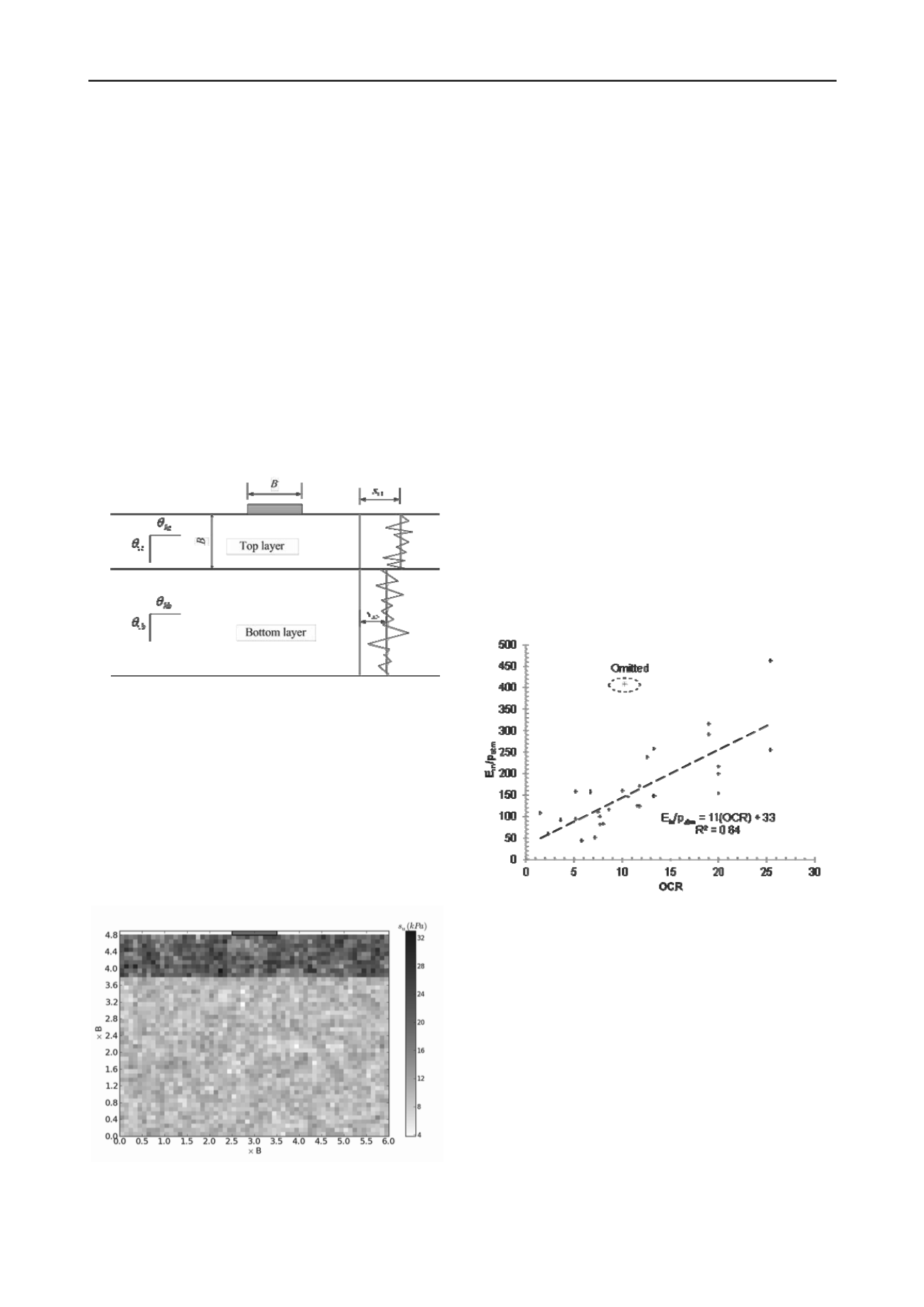
3435
Technical Committee CFMS /
Comité technique CFMS
considerably above those expected under working loads, and (3)
a methodology that is appropriate for all types of geotechnical
materials, even those where the effective stresses change with
time.
The method was investigated by comparing with a load-
settlement test using a 0.91-m diameter footing. In the working
stress range, predicted nonlinear footing settlements matched
quite well with the measured ones (figure 6). The predicted
nonlinear settlements in this range were also in reasonable
agreement with predictions from traditional CPT and SPT
procedures.
3 PROBABILISTIC APPROACHES
3.1
Bearing capacity of shallow foundations
In their paper,
Tian & Cassidy
, from Australia and
Uzielli
,
from Italy, investigate the effect of the spatial variability in
undrained shear strength
S
u
on the bearing capacity of a shallow
strip footing on two-layered stiff-over-soft clay (see figure 6).
Figure 6. Definition of problem being investigated: stiff clay top layer
over soft clay bottom layer.
They analyze the probabilistic assessment of the resistance
factor
N
c
for bearing capacity for a strip footing on a stiff-over-
soft clay profile. The analysis is performed by applying the
Random Finite Element Method, which combines finite
elements simulation, spatial variability analysis and Monte
Carlo simulation.
Finite-element analyses are performed on meshes in which
undrained strength values are assigned on the basis of
quantitative estimates of the vertical and horizontal spatial
variability and the probabilistically modeled scatter of
undrained strength itself (see figure 7).
Figure 7. Example of random field mesh.
The study first results indicate that with high spatial
variability in the undrained shear strength there is a significant
reduction in the bearing capacity.
Mean bearing capacity factors and statistical distributions
were provided for 12 cases of
s
ut
/
s
ub
= 2.
However, the 12 cases presented here represent a small
subset of 1600 cases analyzed in a more ambitious numerical
experiment.
3.2
Settlement of shallow foundations
Generally accepted methods for estimating immediate
settlement of spread footings require the use of linear elastic
models to simulate soil behavior; this approach does not capture
the true non-linear behavior of soil.
Strahler & Stuedlein
present a statistical evaluation of a commonly used elasticity-
based method and soil stiffness correlation using a load test
database. Then, a simple non-linear model capturing observed
load-displacement curvature in footing load tests is presented
and its accuracy is characterized. The undrained initial elastic
modulus is back-calculated using the load test database, and is
found to vary as a function of overconsolidation ratio.
The use of a single undrained Young’s modulus to predict
the highly non-linear response of footings supported on
cohesive soil has been shown to be slightly conservative at low
displacements but increases in error with increasing
displacement. A method to estimate displacements based on the
non-linear Duncan-Chang model was shown to be slightly
conservative and more accurately captures the overall load-
displacement curve. The proposed method also allowed the
estimation of an initial undrained Young’s modulus, which
appears to be correlated with OCR (see figure 8). This trend can
be used to estimate the initial Young’s modulus for use in the
non-linear model or additionally modified to be used in
elasticity based methods.
Figure 8. Back-calculated initial Young’s modulus using Duncan-Chang
model.
Despite the improvement in modeling footing response
reported herein, significant uncertainty in the response remains
without the adequate characterization of inherent soil
variability, transformation error associated with correlations,
and model error. Improved site characterization presents the
best approach to reducing the uncertainty of footing load-
displacement response.
Bungenstab
& al.
from Brazil, discuss about probabilistic
settlement analysis of footings in sands, focusing on the load
curve (estimated settlements). For this purpose, three
methodologies that take the First and Second Order Second
Moment (FOSM and SOSM), and Monte Carlo Simulation
(MCS) methods for calculating mean and variance of the
estimated settlements through Schmertmann’s 1970 equation
are discussed.
The deformability modulus (
E
Si
) is considered varying
according to the division of the soil into sublayers and it is
analyzed as the only independent random variable.
As an example of application, a hypothetical case in state of
Espirito Santo, Brazil, is evaluated. Simulations indicate that


